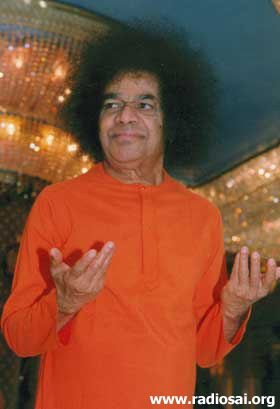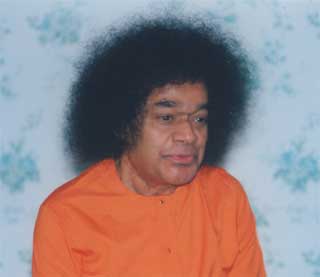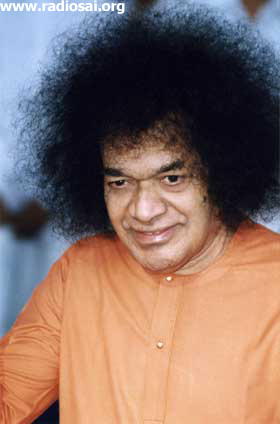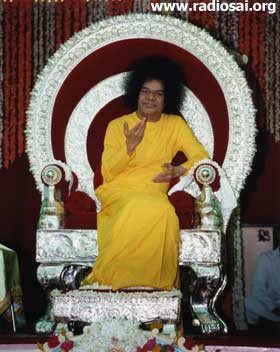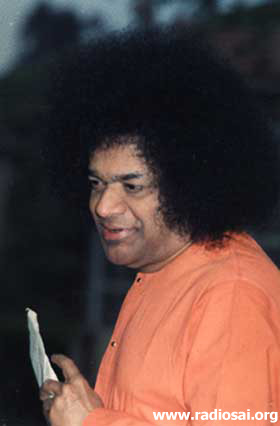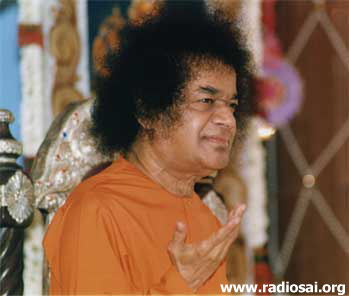 |
 |
 |
 |
| Volume 4 - Issue 07 JULY 2006 |
|
| CONVERSATIONS WITH SAI PART 22 (Continued from the previous issue) |
THE BODY AS THE TEMPLE OF GOD H: Body is like a boil. But Swami often uses the phrase, ‘the body is the temple of God’. SAI: In the spiritual world there is a different arithmetic. 3-1=1. There is you, the mirror, and the image. Remove the mirror, and there is only one left. Life is the mirror, body is the reflection. Be attached to God, and there is only One, God. The body is the temple of God. The life of the person is the priest. The five senses are the vessels used in the religious ceremony. Atma is God, the idol of God. One cannot say that the body is the temple of God unless it is. Every act, thought, and word should be worship in the temple. The five senses should constantly be cleansed and polished, so that the worship is reverently offered to God. One goes to the office and says to himself that every act of the day should be the worship of God, and it will be so. H: Swami says that when the senses leave their place and mix with worldly objects pain and pleasure are produced. What is the proper place of the senses? SAI: It is all the play of desire. Desire for worldly objects produces pleasure and pain, whereas desire for God confers bliss and does not produce pain.
The force, the strength, the energy, and the motivation in desire is God. Whether the desire is good or bad is related to time, place, and person. In early years, a desire for worldly achievement might be good. In later years, the same desire might be bad. Fruit, good one day may be rotten several days later. One side of an apple may become good, the other side rotten. Discrimination says eat the good side and discard the bad. There is another force in you through which God works, and that is discrimination. That force must be used to put aside wrong action. The power of discrimination knows what is right and what is wrong. The wrong desire is God overshadowed by Maya. Whereas discrimination is God less overshadowed by Maya. H: Swami! This really explains the whole problem of good and evil? SAI: Yes. The story of Valmiki is an illustration. He was a ruthless killer and robber without any doubt about his actions. He, at one time, listened to the five sages and started repeating 'Ram'. The same strength and force that made him a terrible criminal was turned to Godly desire and action, and he gained God-realization. Valmiki started to repeat ‘Rama’ and, gaining speed ‘Rama’ became jumbled up with 'Ma' and 'Mara'. In this he lost body sense and transcended the senses. Losing body sense should be like that, natural and not forced. H: Swami says that body, mind, intelligence do not work for anybody, that they do their own work. What does that mean? SAI: What is meant is, 'unfortunately, that is the case'. They are doing their own work, but the work should be co-ordinated for the benefit of the igher. For example, the eyes see. Seeing is their work. But unless they see for somebody there is no point in their work. The mind should be seeing through the eyes. The intelligence should be directing and controlling the mind, for that is the intelligence’s own work.
SAI: 'Surrender' is worldly language. To correctly CONTEMPLATION ON THE FORM OF GOD H: When Swami says, 'The form of the Lord', what does He mean? That is, when I think of the Lord, the image of Baba comes to mind and that is only natural. But beyond that, what? SAI: If you continue to visualize the Form when you are engaged in activity, you will make mistakes. For instance, if you try to visualize the Lord when you are working in the office, you make mistakes. So, when engaged in action, 'Visualizing the Lord' means doing the work in God's Name, and not doing the work to gain the fruit of the work. H: Well, then about the Name, repeating the Name?
SAI: Here is a small example. A man had to pass through 20 miles of forest at night, and he had only a small lantern that lit about a three foot circle. He put down the lantern and started to cry, for he could see for only three feet. Some travellers came along and asked the reason for his sorrow. They exclaimed, 'But sir, if you walk, carrying the lamp with you, if you can see only two feet ahead of you it is enough, and you could travel in that way through a hundred miles of dark forest without trouble. But if you leave the lantern where it is, you cannot move at all in this dark forest.' In the same way, the Name of the Lord may be written in the book you are looking at, but you may find your way only by using the Name. The Name should be woven into the breath so that you are calling on Him all day long. Sohum - 'He am I'. 'He' with the in-breath, 'I' with the out-breath. Or Sai Ram. Or the name of your choice, said with the movement of the breath. Breath is form, thus the name and the form go together.
SAI: The sound of 'OM' is 'AUM'. 'A' starts softly from the throat. It is the earth. ‘U’ comes from the mouth and the sound rises in volume. 'M' is sounded with the lips, with decreasing volume. Like a plane, heard distantly, increasing in sound as it approaches arid fading with distance. 'A' is the world. U is heaven. 'M' is divine, beyond all the senses. H: Suppose one fails to achieve this perfect pronunciation? SAI: The perfect OM is not too important if there is love. Love is the bond of devotion between mother and child, and if the child cries, mother does not worry if the cry is discordant. She rushes to the child and cares for him. The Divine Mother is in every place. Swami is here, but the divine Mother is everywhere. So, everybody has a chance. As soon as a person starts to yearn for God, the Divine Mother is there to respond with grace. In all these matters, love is vital. Devotion to God means love of God. The real OM is spontaneous; it enters through the two nostrils, up to forehead center and out through the ears to the world. Like the broadcast from a radio tower. H: Is not OM a dangerous sound to use? I have heard that the OM sound is continuous, and continuously sustains the universe. Whereas man breaks the continuity of his saying 'OM' and so his life is likewise broken. I have heard of a number of such instances, and it is said that OM is suitable only for sannyasis who have already broken their worldly ties. SAI: What is a sannyasi? There are three types. First is 'cloth sannyasi' who pretends renunciation by wearing an ochre robe. There are thousands of such in India. Next is the 'sense sannyasi' who gains control of his senses. These persons should never leave the world for solitude. They should remain in life where they may watch their reactions and know if their sense control is genuine. Then there is he who has surrendered to the Lord, dedicating the fruit of every action to Him. In this sannyasi, ego has no place. His heart is pure. His senses become calm and are not affected by the opposites. If the heart is pure, then the continuity of the 'OM' sound will not be broken. And, if something that seems bad does arise, then it is unreal, for only OM is real.
H: Should one think, 'He am I'? SAI: No. The sound is 'Sohum'. It is not an Indian word or an American word. It is the sound of what the breath is saying. Of course, it is all right to appreciate the meaning of the sound. H: Swami says that 'Sohum' is the natural sound of breath. Listening to my breath, it does not seem to me that I hear the sound of breath in that way. SAI: The sound through the nose and mouth are mixed with mind or idea, and may be heard in various ways. The fact is that when the mind is without movement and the breath is perfectly spontaneous and natural, the sound of that breath (through the nostrils) is 'Sohum'. Breath through the mouth goes into the stomach. H: Krishna told Arjuna to sound OM in the mind. SAI: OM is in every place, mind, tongue, heart etc. First sound OM on the tongue and then in the mind. The sounding of OM 21 times is important; five outer senses, five inner senses, five lives (the five elements), five sheaths (the kosas), and the Jiva. (To be continued).... – Heart2Heart Team |
| You can write to us at : h2h@radiosai.org |
Vol 4 Issue 07 - JULY 2006
|
Best viewed in Internet Explorer - 1024 x 768 resolution. |
DHTML Menu by Milonic. |
